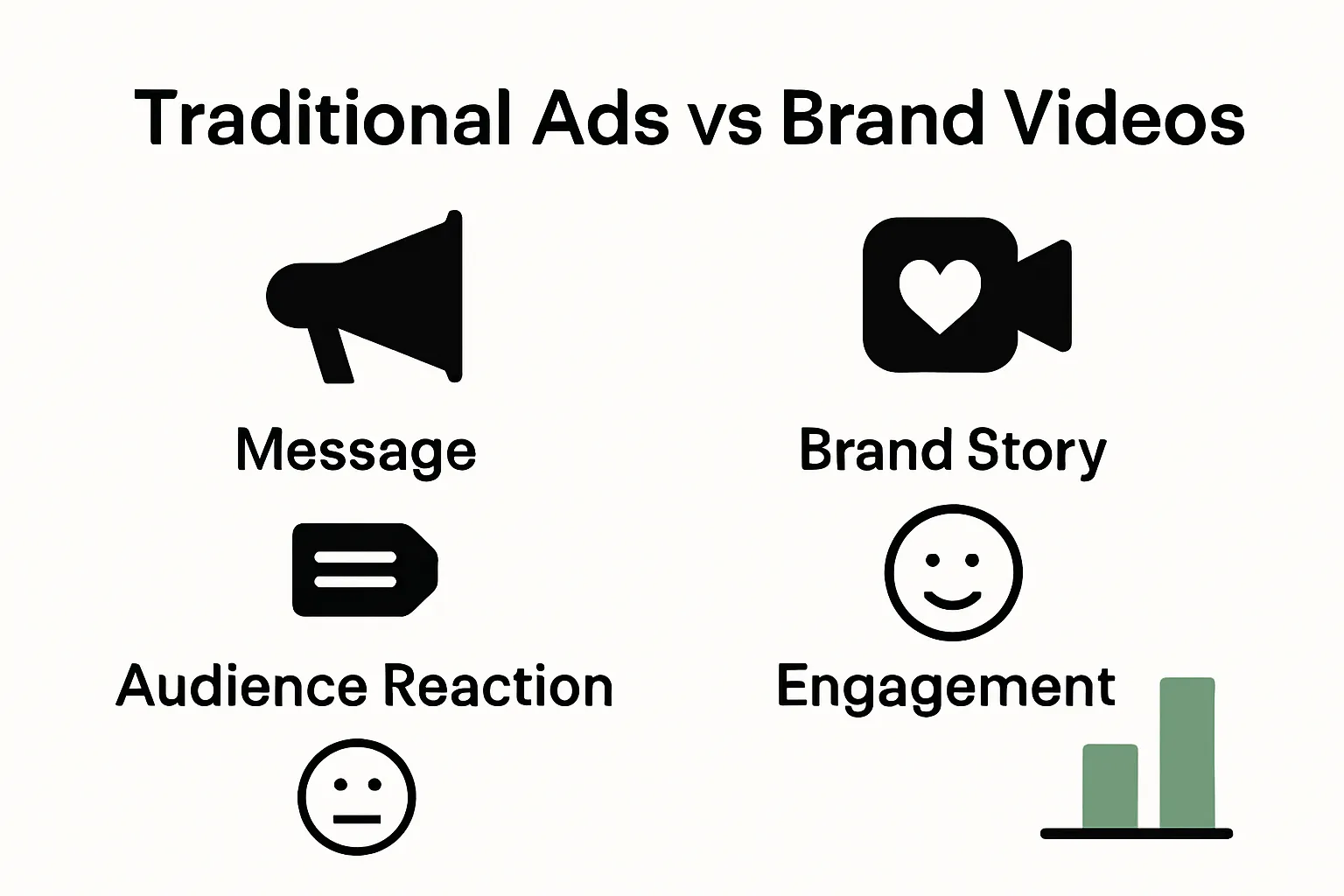Understanding Why Brand Videos Work for Your Business
- Pieter Nijssen
- Oct 7
- 8 min read

Brand videos are changing how companies reach people. The human brain processes visuals about 60,000 times faster than text, which means these stories hit us in powerful ways. Most people think advertising is all about flashy products or catchy slogans, but the real magic happens when a brand video makes you feel something real. That emotional spark is what sticks and keeps you coming back for more.
Table of Contents
Quick Summary
Takeaway | Explanation |
Brand videos build trust and emotional connections. | They reveal a company’s personality, culture, and values, fostering deeper audience engagement. |
Visual storytelling enhances audience retention. | Humans process visuals significantly faster than text, making complex messages more accessible and memorable. |
Effective brand videos show ‘why’ beyond ‘what’. | They express a brand’s mission and unique identity, appealing to shared human experiences rather than just products. |
High-quality production complements emotional storytelling. | While technical quality is important, authenticity and resonance are key to creating memorable narratives. |
Successful campaigns leverage powerful emotional narratives. | Brands like Dove and Nike illustrate how engaging stories transcend traditional marketing, driving consumer loyalty. |
What Are Brand Videos and Their Purpose?
Brand videos are strategic audiovisual storytelling tools designed to communicate a company’s core values, mission, and unique identity beyond traditional advertising methods. Comprehensive brand video research indicates these visual narratives go far deeper than simple product promotion, aiming to forge genuine emotional connections with audiences.
Defining Brand Video Characteristics
A brand video serves multiple critical functions within a company’s marketing strategy. Unlike standard commercials, these videos focus on presenting the human side of an organization, revealing its personality, culture, and underlying philosophy.

They typically accomplish this through:
Storytelling that highlights company values
Showcasing the team and workplace environment
Presenting authentic glimpses into organizational culture
These videos transform abstract corporate concepts into relatable human experiences, helping potential customers understand what makes a brand truly unique. Learn more about video branding strategies to enhance your understanding of this powerful communication tool.
Purpose and Strategic Impact
The primary purpose of brand videos extends well beyond mere product demonstration. They are designed to:
Build trust and credibility
Create emotional resonance with target audiences
Differentiate the brand in competitive markets
By presenting a narrative that resonates with viewers’ aspirations and values, brand videos transform passive viewers into engaged potential customers.
To clarify the difference between traditional commercials and brand videos, here is a comparison of their core characteristics and strategic impacts.
Aspect | Traditional Commercials | Brand Videos |
Focus | Product features and sales | Company values, mission, and identity |
Approach | Direct promotion, short-term sales | Storytelling, long-term brand building |
Emotional Engagement | Often limited | High, aiming for authentic emotional connections |
Audience Connection | General, broad targeting | Deeper, building trust and credibility with target audience |
Content Style | Flashy, catchy slogans or visuals | Relatable, genuine human experiences |
Message Depth | What the company does | Why the company exists, its purpose and philosophy |
Main Goal | Immediate sales or awareness | Differentiation and audience loyalty through authenticity |
The most effective brand videos do not just tell viewers what a company does they demonstrate why the company exists and what makes its mission meaningful.
Modern audiences seek transparency and authentic connections with brands. A well-crafted brand video can communicate complex organizational values in mere minutes, making it an incredibly efficient communication strategy that bridges the gap between corporate messaging and genuine human connection.
The Importance of Visual Storytelling in Marketing
Visual storytelling represents a powerful communication strategy that transcends traditional marketing approaches by transforming complex messages into compelling narratives. Neurological research reveals that human brains are neurologically wired to process and retain information more effectively through visual storytelling, making it an essential tool for modern marketing strategies.
Cognitive Engagement Through Visual Narratives
Marketing professionals recognize that visual storytelling goes beyond aesthetic appeal. It functions as a sophisticated communication mechanism that activates multiple cognitive processes simultaneously. Visual stories engage viewers on emotional and intellectual levels, creating deeper connections that traditional text-based communication cannot achieve.
The human brain processes visual information approximately 60,000 times faster than text, which means visual narratives can communicate complex ideas instantaneously. Discover more about visual branding techniques to leverage this powerful communication strategy effectively.
Strategic Elements of Visual Storytelling
Effective visual storytelling in marketing incorporates several critical components:
Emotional resonance with target audience
Clear narrative arc with meaningful progression
Authentic representation of brand identity
Strategic use of visual metaphors and symbolism
These elements work together to transform marketing content from mere information transmission to genuine audience engagement. By crafting narratives that reflect shared human experiences, brands can create memorable connections that transcend traditional advertising approaches.
Marketing professionals understand that modern consumers seek meaningful interactions, not just product information. Visual storytelling provides a nuanced approach to communicating brand values, allowing companies to showcase their unique identity through rich, immersive narratives that resonate deeply with viewers.
How Brand Videos Influence Consumer Behavior
Brand videos represent a sophisticated psychological mechanism for influencing consumer perceptions and purchasing decisions. Psychological research on emotional marketing demonstrates that visual narratives trigger complex neurological responses that significantly impact consumer behavior beyond traditional advertising approaches.
Psychological Mechanisms of Video Engagement
Emotional connection plays a critical role in how brand videos shape consumer perception. These videos tap into fundamental psychological triggers that transform passive viewers into engaged potential customers. By presenting authentic narratives that resonate with viewers’ personal experiences, brands create powerful emotional pathways that bypass rational decision-making processes.
The human brain processes visual information dramatically faster than text, allowing brand videos to communicate complex messages instantaneously. Learn more about video branding strategies to understand these sophisticated communication techniques.
Key Behavioral Influence Strategies
Brand videos strategically employ multiple psychological techniques to influence consumer behavior:
Creating instant emotional resonance
Establishing trust through authentic storytelling
Demonstrating brand values beyond product features
Triggering mirror neurons that promote empathy
Simplifying complex information through visual narratives
These strategies work synergistically to transform viewers from passive observers into potential brand advocates. By presenting narratives that reflect shared human experiences, companies can create deep psychological connections that transcend traditional marketing approaches.
Below is a table summarizing the key psychological techniques brand videos use to influence audience behavior, based on concepts covered in the section.
Influence Strategy | Description |
Emotional Resonance | Creating instant feelings that align with viewer values |
Authentic Storytelling | Building trust by sharing genuine narratives |
Values Beyond Product | Showing brand beliefs, not just product features |
Empathy Through Mirror Neurons | Evoking empathy by reflecting relatable situations |
Simplifying Complex Information | Using visuals to make ideas easier to grasp |
Modern consumers seek genuine connections with brands. Brand videos provide a sophisticated platform for communicating organizational identity, values, and mission in ways that traditional advertising cannot achieve. The most effective videos do not merely sell products they create meaningful emotional experiences that align with viewers’ personal aspirations and worldviews.
Key Elements of Effective Brand Videos
Creating impactful brand videos requires a strategic blend of technical skill and storytelling prowess. Marketing communication research reveals that successful brand videos must synthesize multiple critical components to truly resonate with audiences.
Narrative Structure and Emotional Authenticity
Compelling storytelling forms the foundation of effective brand videos. These visual narratives must transcend mere product promotion, instead creating genuine emotional connections that reflect the brand’s core identity. The most successful videos craft a narrative arc that feels both authentic and relatable, allowing viewers to see themselves within the brand’s story.
Explore deeper insights into brand video strategies to understand the nuanced approach required for meaningful visual communication.
Technical and Emotional Design Elements
Effective brand videos integrate several key design principles:
Clear and concise messaging
High-quality visual production
Authentic emotional tone
Strategic pacing and rhythm
Seamless narrative progression
These elements work together to create a cohesive viewing experience that captures and maintains audience attention. Technical quality must complement emotional storytelling, ensuring that the video’s visual and narrative components reinforce each other.
The most successful brand videos understand that emotional connection trumps technical perfection. While production quality matters, the ability to create a genuine, resonant narrative that reflects shared human experiences is ultimately what transforms a good video into a memorable brand communication tool. Viewers seek stories that reflect their own aspirations, challenges, and values, making authenticity the most critical element in any brand video strategy.

Real-World Examples of Successful Brand Videos
Successful brand videos demonstrate the transformative power of strategic visual storytelling across diverse industries. Marketing case studies reveal how innovative companies leverage video narratives to create profound audience connections and drive significant business outcomes.
Breaking Through with Emotional Storytelling
Innovative brands understand that effective video marketing transcends product features, instead focusing on creating meaningful emotional experiences. Companies like Dove have masterfully employed brand videos that challenge societal norms, generating widespread engagement by addressing deeper human experiences rather than traditional advertising approaches.
Discover more about effective brand video strategies to learn from industry leaders’ successful approaches.
Strategic Video Campaign Approaches
Companies across different sectors have demonstrated remarkable success through distinctive video strategies:
Nike’s inspirational athlete narratives
Apple’s minimalist product storytelling
Airbnb’s user experience documentaries
Google’s heartwarming human-centered campaigns
Red Bull’s extreme sports adventure videos
These examples illustrate how strategic storytelling can transform brand perception. Each video goes beyond traditional marketing by creating narratives that resonate with viewers’ aspirations, challenges, and emotional landscapes.
The most compelling brand videos do more than showcase products. They create immersive experiences that invite viewers into a broader narrative, positioning the brand as a meaningful participant in human stories. By understanding audience psychology and crafting authentic, emotionally intelligent visual narratives, these companies have redefined marketing communication, turning passive viewers into engaged brand advocates.
Turn Emotional Storytelling Into Business Growth With Tulip Films
Are you struggling to create a brand video that truly captures your company’s personality and builds a real connection with your audience? The article above highlights how powerful visual storytelling is when it comes to creating trust and influencing customer decisions. But knowing why brand videos work is just the first step. To stand out, you need more than surface-level content. You need carefully crafted videos that show your mission, values, and what makes your brand different—exactly what Tulip Films specializes in delivering.

If you want your business to move beyond generic advertising and create brand videos that leave a lasting impact, visit Tulip Films. Discover how our personalized video solutions help Swiss businesses connect on a deeper level. See real examples of our recent work and learn how we use visual storytelling to drive audience engagement. Plan your free consultation now and let us turn your brand’s story into confident results your customers remember.
Frequently Asked Questions
What are brand videos?
Brand videos are strategic audiovisual narratives that communicate a company’s values, identity, and mission, aiming to create emotional connections with audiences beyond standard advertising.
How do brand videos build trust with customers?
Brand videos build trust by showcasing authentic storytelling that reflects a brand’s culture and values, allowing viewers to connect on an emotional level and understand the brand’s purpose.
Why is visual storytelling important in marketing?
Visual storytelling is important because it engages viewers on both emotional and intellectual levels, making complex messages more relatable and easier to retain, which is more effective than traditional text-based communication.
What key elements make a brand video effective?
Effective brand videos incorporate compelling storytelling, high-quality visuals, clear messaging, authentic emotional tone, and a seamless narrative arc to create an engaging viewing experience.
Recommended